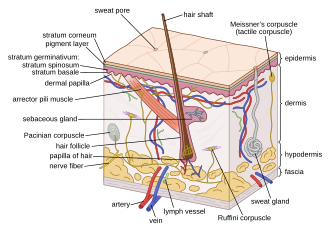 The human body is a complex and intricately designed system made up of various organs, each serving a specific and often vital function. While most people tend to think of internal organs like the liver, brain, or heart when discussing the human body�s most essential parts, many are surprised to learn that the skin is not only the largest organ by surface area but also the heaviest organ in the human body.
The human body is a complex and intricately designed system made up of various organs, each serving a specific and often vital function. While most people tend to think of internal organs like the liver, brain, or heart when discussing the human body�s most essential parts, many are surprised to learn that the skin is not only the largest organ by surface area but also the heaviest organ in the human body.
Basic Facts About the Skin
The skin is a remarkable and multifunctional organ that performs a wide range of essential roles for the body. In an average adult, the skin covers approximately 1.5 to 2 square meters (roughly 16 to 22 square feet) and weighs between 3.5 to 10 kilograms (7.5 to 22 pounds), depending on the individual�s size, body composition, and hydration levels. This accounts for about 15% of an individual�s total body weight, making it the heaviest organ in the human body.
Anatomical Structure of the Skin
The skin is composed of three primary layers, each with its own specific structure and function:
- Epidermis:
- The outermost layer of the skin.
- Made up primarily of keratinocytes, which produce keratin, a protein that gives skin its strength and waterproof properties.
- The epidermis also includes melanocytes (which produce pigment), Langerhans cells (immune response), and Merkel cells (touch sensation).
- Constantly renews itself every 28�40 days.
- Dermis:
- Located beneath the epidermis.
- Contains connective tissue, blood vessels, lymph vessels, nerves, hair follicles, and sweat glands.
- Rich in collagen and elastin fibers, which provide elasticity and strength.
- Supports thermoregulation and supplies nutrients to the epidermis.
- Hypodermis (Subcutaneous Tissue):
- The deepest layer of the skin.
- Consists largely of adipose (fat) tissue and connective tissue.
- Serves as insulation, shock absorption, and energy storage.
Functions of the Skin
The skin is more than just a covering for the body; it plays several vital roles:
- Protection:
- Acts as a physical barrier against pathogens, chemicals, UV radiation, and mechanical injury.
- Prevents excessive water loss from the body.
- Regulation:
- Helps maintain body temperature through sweating and vasodilation/vasoconstriction.
- Regulates water and electrolyte balance.
- Sensation:
- Houses millions of nerve endings that detect touch, pressure, pain, temperature, and vibration.
- Excretion:
- Sweat glands help excrete small amounts of metabolic waste, such as urea and salts.
- Vitamin D Synthesis:
- Exposure to sunlight allows the skin to produce vitamin D3, critical for calcium absorption and bone health.
- Immune Defense:
- Contains specialized immune cells that identify and combat pathogens.
Skin Diversity and Adaptation
Human skin varies significantly among individuals and populations, adapting to different environments through evolutionary processes:
- Pigmentation: Varies due to melanin concentration, influenced by genetic background and UV exposure.
- Thickness: Varies depending on location; the skin is thinnest on the eyelids and thickest on the palms and soles.
- Texture: Influenced by genetics, age, hydration, and environmental factors.
Common Conditions Affecting the Skin
Due to its constant exposure and extensive surface area, the skin is susceptible to a wide variety of conditions:
- Acne
- Eczema (Atopic Dermatitis)
- Psoriasis
- Skin Cancer (Melanoma, Basal Cell Carcinoma, Squamous Cell Carcinoma)
- Infections (bacterial, viral, fungal)
- Allergic reactions and rashes
Maintaining healthy skin requires proper nutrition, hydration, hygiene, and protection from excessive sun exposure.
Scientific and Medical Importance
Because the skin is the body�s outermost layer and largest sensory organ, it is often the first to show signs of internal disease or systemic problems. Dermatological examinations can lead to early diagnoses of serious conditions, including autoimmune disorders, liver disease, and infections. Furthermore, the skin is also a focus of research in regenerative medicine, tissue engineering, and cosmetic dermatology.
In medical emergencies such as burns, large-scale skin damage can be life-threatening due to fluid loss, infection risk, and disruption of body temperature regulation. This underscores its importance as more than just a �cover� but a fully functional and indispensable organ.
The skin stands out as a marvel of biological engineering: it is the largest and heaviest organ of the human body, and yet it remains one of the most overlooked in discussions of organ health. It performs a wide range of vital functions that keep us alive, protected, and connected to the world around us. From safeguarding our internal systems to enabling us to sense and interact with our environment, the skin plays a critical and complex role in maintaining homeostasis and overall well-being. As both a scientific subject and a cultural symbol, the human skin continues to captivate researchers, healthcare professionals, and artists alike.







